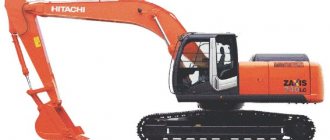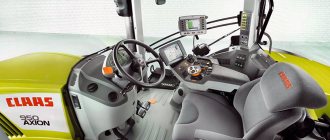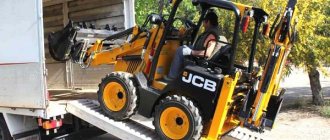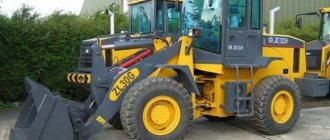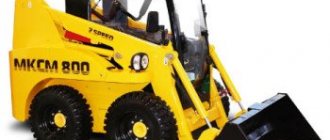History of Fuchs
- In 1888, the blacksmith Johannes Fachs founded the Fuchs company, which was engaged in improving agricultural machinery.
- In 1952, the first Fuchs loading machine was produced: the wheeled cable excavator could be used equally for lifting and excavation work.
- In 1962, the popular F-301 model began to be mass produced, up to 170 units. per month. In total, about 17,000 of these excavators were produced.
- In 1975, FUCHS received a patent for a telescopic mount for the operator's cab.
- In 1985, FUCHS is absorbed by the Schaeff Group.
- In 2002, the Schaeff Group was in turn absorbed by the Terex Group.
Advantages of the Fuchs technique
Fuchs special equipment is a leader among machines for handling large volumes both on an open work site and indoors. The machine is thought out to the smallest detail and improved by meticulous German engineers.
The Fuchs loader has undeniable advantages, including:
- high stability design;
- impeccably accurate and smooth hydraulic system;
- speed up to 20 km/h, excellent maneuverability and the ability to lower the cabin during transportation;
- high-power engine produces 99% less soot than analogues;
- there is a height limitation, the ventilation system is designed for indoor operation;
- The quick release system makes changing attachments easy.
A new material handler has a high cost, so buyers often look for used special equipment. will help you purchase a used Fuchs material handler in excellent technical condition. We will select a model that meets your needs and deliver it from Europe to any region of the Russian Federation.
Fuchs MHL 434 material handler
Loader Fuchs MHL 434 - Grab loader.
FUCHS machines are perfectly adapted to work in various climatic conditions - engine heating in winter and air conditioning for comfortable work in the hot season have long become standard equipment for each machine. Wide visibility, a comfortable seat with numerous adjustments and air suspension make the operator’s work as easy as possible and increase its productivity. Everyone who has had the opportunity to operate FUCHS loaders notes the accuracy and ease of operation when moving loads, which would not be possible without the use of automatic control and control systems.
A well-thought-out design, the use of a central automatic lubrication system, and excellent access to all components and assemblies significantly reduce the time for servicing the machines and at the same time extend their service life.
The company's designers managed to maintain an ideal balance between the modern equipment of the machine and the ease of its maintenance.
Electronic systems constantly monitor and optimize engine and hydraulic performance depending on load. The operator does not need to make adjustments to this process. This creates the effect of ease and simplicity of work on the loader.
Where are loaders used?
Fuchs material handlers are ready for intensive work even in harsh conditions. They are typically used in the following industries:
- metallurgical industry and metalworking;
- waste disposal;
- construction and repair work;
- logging and woodworking.
Based on the task, the equipment can be equipped with the following designs:
- double-jaw grab for moving bulk materials;
- multi-jaw grab for scrap metal, wood and construction waste;
- crane gripper for moving loads using cables and hooks;
- a washer-magnet for capturing metal objects.
Fuchs material handlers are used for the rapid transportation of cargo and heavy objects, performing loading and unloading operations: moving, unloading and loading scrap metal into railway cars or scrap trucks. Reloaders are also used in logging, waste disposal, etc.
These lifting units can move loads while remaining in place, or carry heavy objects on tracks. Their important advantage is versatility: if necessary, you can supplement the machine design with scissors for cutting reinforcement and dismantling metal structures.
Specifications
Mobile Fuchs equipment is based on a wheeled or tracked chassis. There are modifications that are installed permanently on a pylon or supports. Wheeled vehicles are equipped with drive axles with planetary gearboxes and a drum brake mechanism in the hub. The front axle is rigidly fixed to the frame, the wheels are turned using knuckles with hinges. The rear beam swings in a vertical plane, there is a hydraulic mobility lock.
On tracked vehicles, belts with lugs are used; the link width is up to 800 mm. To install pylons with a height of up to 7 m, a reinforced chassis is used. The track tension is carried out by automatic hydraulic devices. Stationary machines do not have a running gear and are installed on adjustable hydraulic supports with clamps.
The power units used on the loaders are 4- or 6-cylinder in-line Deutz turbodiesels, developing power from 116 to 408 hp. The engines are liquid-forced cooled; a fan with reversible direction of rotation is available upon request. This option allows you to independently clean the radiator honeycombs from dust. Some cars are equipped with urea injection, which allows them to comply with emissions standards Euro 4 and higher.
A hydrostatic transmission is used to transmit torque. The design includes an axial piston pump and an actuator motor equipped with a travel brake valve. Additionally, a 2-speed manual transmission is installed, distributing power between the drive axles. The service brake system is hydraulically driven and has a disc-type parking brake.
An electric motor is used as the power unit. A reel with a power cable is installed on the machine, which is connected to an industrial power supply. Changing the speed of movement is carried out by adjusting the engine speed.
Important Mustang KamAZ-6350: technical specifications, instruction manual
Loaders use a slewing ring in the form of a 2-row circle with internal gearing. The rotation of the working part is carried out from a multi-stage planetary gearbox, equipped with a disc brake with several working surfaces. The rotation speed is stepless, reaching 6-7 rpm. The brake mechanism drive is electric.
The Fuchs grab loader is equipped with the following equipment:
- lifting hook, lifting capacity depends on the modification of the machine;
- multi-jaw grab bucket of open or closed type;
- grab buckets for moving bulk cargo, the capacity of the unit depends on the density of the cargo.
The operator's workplace is located in a metal cabin mounted on a hydraulic boom. Raising the cab upward improves visibility during loading operations. Standard equipment includes air conditioning and a heater that is not connected to the engine cooling system. The efficiency of the air conditioning system does not depend on the speed of the power plant. The loader is controlled using joysticks. The operator's seat has a pneumatic support, headrest and seat belt.
Hyperion - sale of special equipment in Kaliningrad
If you are looking for favorable prices for special equipment from Europe, contact Hyperion LLC. We provide a full range of services for the sale of European special equipment. Based on your order, we will select the optimal model of special transport for you at European sites and deliver it to Russia.
Thanks to partnerships with suppliers in the European Union, our clients purchase special equipment at the best prices in Kaliningrad. And the close location of the Kaliningrad region to the EU allows us to significantly minimize the financial and time costs of customers for transportation and customs clearance of equipment.
To buy a Fuchs material handler or other models of cargo and special transport, call us. The manager will advise you and help you choose the optimal model.
Technical specifications Fuchs MHL 460
| Main characteristics | |
| Full title | Logger Fuchs MHL 460 |
| Total weight, kg | 33000-34000 |
| Engine | |
| Engine model | BF6M 1013 |
| engine's type | turbodiesel |
| Number and arrangement of cylinders | 6 |
| Engine displacement, cm3 | 7100 |
| Engine power, kW (hp) | 165 |
| Estimated rotation speed, rpm | 2000 |
| Engine manufacturer (brand) | Deutz |
| Transmission | |
| Transmission | Hydrovolumetric |
| Fuel system | |
| Maximum speed, km/h | 20 |
| Electrical equipment | |
| Batteries (voltage/capacity), V/Ah | 2×12/100 |
| Brake system | |
| Service brakes | Hydraulically controlled braking system |
| Parking brakes | Hydraulically controlled disc brake |
| Refill tanks | |
| Fuel tank, l | 350 |
| Hydraulic tank, l. | 380 |
| Wheels | |
| Tires | 20.5 R 25 (12.00-20) |
| Driving performance | |
| Outer overall turning radius, mm | 9500 |
| Loader characteristics | |
| Davl. Hydraulics (hydraulic system/attachments), bar | 360 |
| Excavator characteristics | |
| Platform rotation speed, rpm. | 8 |
| Other characteristics | |
| Hydraulic pump flow, l/min | 640 |
| Selecting a loader manufacturer All manufacturers |
| Amkodor Borex VTZ VgTZ Volzhsky forklift Donex Dorelectromash Elaz Inter-Don Kirovets Kranex Kurganmashzavod LTZ Lvov forklift MZiK |
Important Model range of Russian KamAZ trucks
| Excavator Fuchs MHL 474 Excavator MHL 474, Fuchs, — Excavators |
| Excavator Fuchs MHL 464 Excavator MHL 464, Fuchs, — Excavators |
| Excavator Fuchs MHL 454 Excavator MHL 454, Fuchs, — Excavators |
| Excavator Fuchs MHL 434 Excavator MHL 434, Fuchs, — Excavators |
| Excavator Fuchs MHL 380 Excavator MHL 380, Fuchs, – Excavators |
| Excavator Fuchs MHL 360 Excavator MHL 360, Fuchs, — Excavators |
| Excavator Fuchs MHL 340 Excavator MHL 340, Fuchs, – Excavators |
| Excavator Fuchs MHL 331 Excavator MHL 331, Fuchs, — Excavators |
